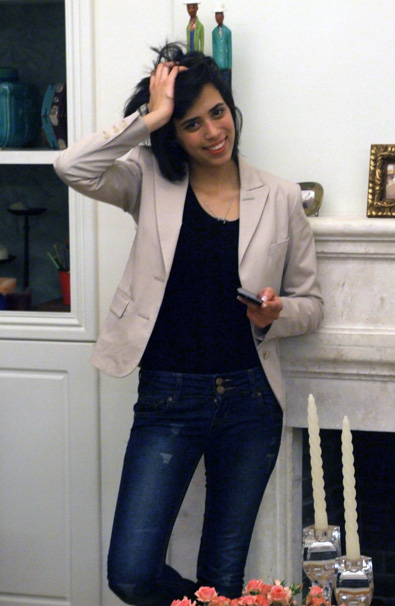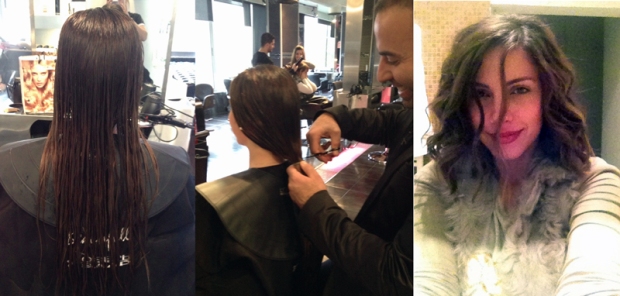Model, beauty queen, television host, fashion stylist, wife, mother – and most recently – blogger, Rita Lamah Hankach is a woman of as many titles as the passions she pursues in life. Rita has proven to be an ideal role model for young Lebanese women with her radiant beauty, both on the outside and on the inside. Alongside earning the second runner-up “Miss Lebanon” title in 2003 and honors in other beauty pageants, Rita has hosted a range of different television shows on Future TV and worked as the executive manager of famed Lebanese designer Zuhair Murad.

Rita, on the left, at Miss Lebanon 2003 (Photograph source: Lebanese Pageant)
Earlier this year, Rita donated a record 40 cm of her long locks for our “Make the Cut” hair donation campaign. It came as a delightful surprise to us and a gesture that has undoubtedly inspired others around her to also follow suite.
We took a few minutes with Rita to get a more intimate understanding of that experience and what it meant for her:
1. You recently made the cut and donated a generous 40 cm of your hair to our campaign. What inspired you to take this drastic step?
My cousin, Karen. One day, she came to my place with a totally new haircut and told me about how she had donated her hair.

Karen, Rita’s cousin, with her new haircut after donating (Photograph source: Life and Style and Co)
2. How was the experience for you? Did you decide in advance how much you would end up cutting?
The moment Karen told me her story, I decided that I would do it too and cut my hair short. It would grow back before I even knew it!
3. Have you donated your hair before? If so, when?
No, never.

It would be the first time Rita would make such a drastic cut (Photograph source: Life and Style and Co)
4. How have people responded to this change in your hairstyle and to your reasons for doing this?
My hair was very long and I took really good care of it. Everybody around me knew that. They called me crazy at first when I made this decision, but once they knew the reason behind doing it, they were very encouraging.
As for the hairstyle itself, I guess it wasn’t easy for my close friends to quickly adapt to it, especially since I’ve had long hair forever. It took me some time to get used to it myself.
5. Would you encourage others to make the cut? If so, how?
Definitely yes! I have also done two interviews on TV about the experience and have shared about it on my blog to encourage people.

Before, during and after the cut (Photograph source: Life and Style and Co)
6. Although many women don’t like wearing wigs during their treatment, the majority in Lebanon do whether for discretion of their sickness or to regain a sense of self. What’s your perspective on the role of wigs in helping a breast cancer patient cope? Are you for or against a patient wearing a wig during this period in their life?
Wearing a wig during treatment is very important and helpful – especially for a woman who might have already lost a very valuable part of her body because of breast cancer.
On the other hand, we should also work more on encouraging our society to accept this disease as cancer could happen to any of us. It should not be treated as a taboo.
7. We’ve all unfortunately been affected by cancer in one way or another – whether directly or indirectly through a friend or family member who’s had it. What is your relationship to this cause and what have you personally discovered through it?
Well, the person that I needed most in my life got affected by cancer. My mom fought it for two years before passing away at the age of 36. I was only 14 at the time! I remember I didn’t know what was wrong with her back then because of the social taboo I mentioned before.
My mom used to wear wigs and I guess I was in a state of denial. I didn’t want to admit or even think for a second that a disaster could happen to us – and it is a disaster indeed!
What did I discover? That cancer is a despicable, ugly, mean, evil disease that could happen to anyone at anytime in our lives.
We just have to live with it, try to enjoy our lives with our loved ones, and if we pray to God, we will definitely survive this awful experience.
8. Do you think there’s enough awareness about breast cancer in Lebanon? What do you think can be done more to help the women being diagnosed with it?
The campaign you’re doing is definitely helpful and different, however, I think it should be promoted further so that more women are aware of it.
Offering a free diagnosis in order to encourage everybody to get checked is also very important.
We’d like to thank Rita for donating and for sharing with us so openly about this important subject. If you wish to keep up with her latest news and projects, be sure to follow her blog: Life and Style and Co
Find out more about our “Make the Cut” hair donation campaign and check the hair donation guidelines here.






















